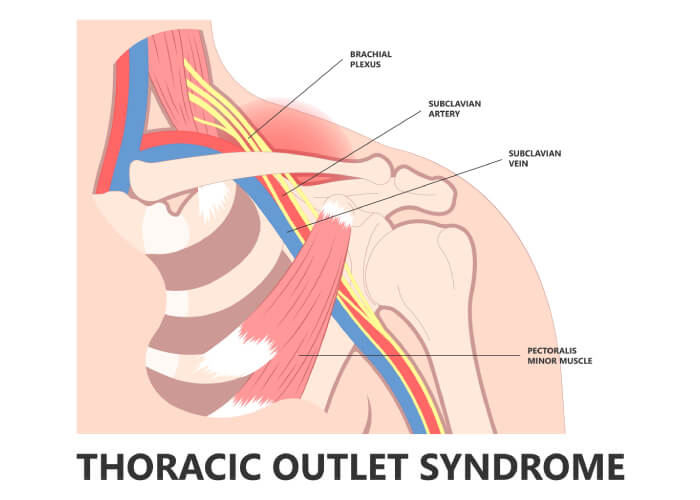
Introduction
Thoracic Outlet Syndrome (TOS) refers to a collection of symptoms in the shoulder and forearm and hands which result in pain, numbness, tingling and weakness in the arm or hand.
These conditions result from compression of Arteries, Nerve and Veins which pass through a narrow area at the front of the lower neck referred to as the Thoracic Outlet.
The Thoracic Outlet is a space between your first rib and your collarbone (clavicle)
Important structures including the Subclavian artery, vein, and nerves (the brachial plexus: a complex network of nerves from the neck region) pass through the Thoracic Outlet
Types of Thoracic Outlet Syndrome
This is based on the upon the structures involved.
Thoracic outlet syndrome can be:
- Neurogenic – accounts for over 90% of cases, which involves Nerves of from the Cervical Region of the Spine (these control movements of the shoulder, arm and hand). This results numbness, pain and sometimes even weakness in the arm muscles.
- Venous – the second most common cause accounting for approximately 10% of cases. It is caused by mechanical compression and irritation of the subclavian and axillary veins between the clavicle and first rib. This can slow down or obstruct blood flow causing a potential clot and a medical emergency
- Arterial – the least common accounting for approximately 5% of cases. This it is often a result of the subclavian artery becoming compressed within the Scalene triangle. It can also develop into a medical emergency, so careful examination is vital.
What are the signs and symptoms of thoracic outlet syndrome?
- Numbness and/or tingling in the affected arm
- Cold hands and a pale blue discoloration of the fingertips
- Pain and swelling in the neck, arm, and hand
- Weakness in the of muscles of the involved limb
- Absent or weak pulse in the arm (as felt by a clinician or therapist)
What are the causes of Thoracic Outlet Syndrome?

TOS can have several causes, including:
- Poor posture – Drooping or rounded shoulders along with protracted Scapula (Shoulder blade) This narrows the area of the thoracic outlet making compression more likely.
- Congenital anatomical abnormalities – Cervical Rib (extra rib in the neck) and anatomical variations in the neck bone structures
- Trauma – an injury resulting from a traumatic event such as collarbone fracture
- Serious – Cancers in the arm and upper chest can put pressure on the region
Diagnosis and Tests
A careful history and examination is extremely important, as there are many conditions that mimic TOS.
Clinical examination includes Adson’s test and Roos test. The latter is one of the most used tests in diagnosing Thoracic Outlet Syndrome.
Tests are guide by physical examination findings and the type of suspected TOS.
Imaging tests include X-rays of the neck and chest to rule out cervical spine abnormalities, and looking for the presence of cervical rib (extra neck rib)
Other tests include Nerve conduction tests or even Vascular studies to detect any abnormalities present in the blood vessels. Occasionally CT or MRI scans may also be requested in complex cases.
How is Thoracic Outlet Syndrome treated?
The treatment aims to decrease symptoms and manage pain. The options vary according to the type of TOS, and symptoms.
Your doctor or therapist will discuss the most appropriate treatment which can often be as simple as tailored manual therapy.
Neurogenic TOS (Physical therapy)
- Osteopathy aims to relieve muscle tension, increase mobility, range of motion, and improve stiffness in the neck and upper limb region. The patient is educated on specific postural adjustments and stretches.
- Soft Tissue Mobilisation (STM) – This is a technique in which light pressure is applied and stretching movements of the muscles and tendons are performed. This reduces the pressure on the structures in the Thoracic Outlet.
- Deep tissue massage – This target the deep muscles of the neck and arm and is more deeper than mobilisation. This technique involves applying sustained pressure on certain muscle trigger points including the scalene muscles. The Scalene muscles are three muscles which are connected to the neck and rib. These are prone to becoming ‘tight’ with everyday posture such as rounded shoulders from driving or sitting a desk for prolonged periods. This helps reduces muscle tension, break any myofascial adhesions, improves blood flow and helps decompresses nerves and vessels.
- Chiropractic : here often a manipulation of the cervical spine and upper ribs is performed to allow a ‘release’ of any structures which may be in ‘locked’ or in spasm.
Soft Tissue Mobilisation
Neck (cervical) muscles which are affected by TOS, can be effectively treated via soft tissue mobilization. This is often a therapy performed by Osteopaths and Massage therapists.
Gentle mobilisation of the sternocleidomastoid and scalene muscles along with the pectoralis muscles can help open out the thoracic outlet. Often the shoulder area is also treated in particular the rotator cuff to help with shoulder movement and posture and ease the protraction of the Scapula which may be contributing to the problem
Deep tissue massage of cervical muscles
Cervical muscles are massaged with pressure, out of which the scalene muscles are discussed here due to high risk of being affected by TOS. Deep Tissue Massage to both the Pectoralis minor attachment on the Coracoid process and
the Deeper Scalene Muscles is very effective and results can be felt relatively quickly with an easing of symptoms.
Conclusion
Thoracic outlet syndrome can be a debilitating condition, but is thankfully treatable if caught early. However, consulting a clinician early is crucial to prevent long term and potentially serious complications if the condition is allowed to progress.
Think you be suffering from Thoracic Oulet Syndrome and need further help? Feel free to contact MyMSK clinic on 0333 772 9655
